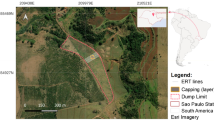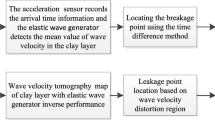Abstract
In order to improve the detection accuracy of vertical barrier leakage, three contamination leakage working conditions, including point leakage only, point and vertical leakage, and horizontal leakage, were simulated by small-scale soil tank tests. The dynamic evolution of soil resistivity over time was monitored by electrical resistivity tomography (ERT). The accuracy of the ERT detection results was validated through thermal tracer method, chloride tracer method, and soil true resistivity experiments. The results indicate that the resistivity profiles at different times can more accurately reflect information on the location of leakage points, the extent of contamination plumes, and the migration pathways of pollutants under different working conditions. The extent of anomalous areas in resistivity profiles is a crucial factor in representing the geometric shape of pollution leakage. However, the preferential seepage or lateral migration of contaminant in the soil significantly reduces the detection accuracy of ERT for identifying leakage points. The thermal tracer method and the chloride tracer method can produce better complementary interpretations of ERT monitoring results. The measurement points near the leakage point exhibit faster temperature response rates, which can serve as a characteristic for identifying the location of leakage points. Compared with the thermal tracer method, the chloride tracer method can monitor the migration of contaminants over a larger range. Therefore, the proposed combined diagnostic detection method in this paper presents a feasible solution with promising engineering applications in leakage detection for vertical barrier barriers.
Graphical abstract
















Similar content being viewed by others
Data availability
The datasets used and/or analyzed during the current study are available from the corresponding author on reasonable request.
References
Anderson EI, Mesa E (2006) The effects of vertical barrier walls on the hydraulic control of contaminated groundwater. Adv Water Resour 29(1):89–98
Anderson MP (2005) Heat as a ground water tracer. Ground Water 43(6):951–968
Brusseau ML, Nelson NT, Zhang Z, Blue JE, Rohrer J, Allen T (2007) Source-zone characterization of a chlorinated-solvent contaminated Superfund site in Tucson. AZ J Contam Hydrol 90(1-2):21–40
Buselli G, Lu K (2001) Groundwater contamination monitoring with multichannel electrical and electromagnetic methods. J Appl Geophys 48(1):11–23
Chen YY, Feng ZL, Yang JL, Wu FD (2016) Leakage positioning method of landfill base on distributed optical fiber temperature measurement system. Chin J Environ Eng 10(10):6087–6092
De Carlo L, Perri MT, Caputo MC, Deiana R, Vurro M, Cassiani G (2013) Characterization of a dismissed landfill via electrical resistivity tomography and mise-à-la-masse method. J Appl Geophys 98:1–10
de Franco R, Biella G, Tosi L, Teatini P, Lozej A, Chiozzotto B, Giada M, Rizzetto F, Claude C, Mayer A, Bassan V, Gasparetto-Stori G (2009) Monitoring the saltwater intrusion by time lapse electrical resistivity tomography: the Chioggia test site (Venice Lagoon, Italy). J Appl Geophys 69(3-4):117–130
Deng YP, Shi XQ, Xu HX, Sun YY, Wu JC, Revil A (2017) Quantitative assessment of electrical resistivity tomography for monitoring DNAPLs migration — comparison with high-resolution light transmission visualization in laboratory sandbox. J Hydrol 544:254–266
Dong LY, Tang WJ, Chen JY, He M (2022) Interfacial hydrological process of heat tracing: research progresses and development trends. J Yangtze River Sci Res Inst 39(04):21–26+33
Du YJ, Shen SL, Liu SY, Hayashi S (2009) Contaminant mitigating performance of Chinese standard municipal solid waste landfill liner systems. Geotext Geomembr 27(3):232–239
Engelmann C, Handel F, Binder M, Yadav PK, Dietrich P, Liedl R, Walther M (2019) The fate of DNAPL contaminants in non-consolidated subsurface systems — discussion on the relevance of effective source zone geometries for plume propagation. J Hazard Mater 375:233–240
Fu XL, Du YJ, Shen SQ, Bi YZ, Zhang R (2020) Chemico-osmotic membrane behavior and diffusive properties of PAC amended bentonite/sand vertical cutoff wall backfills. Chin J Rock Mech Eng 39(S2):3669–3675
Han LH, Liu SY, Du YJ (2006) New method for testing contaminated soil—electrical resistivity method. Chin J Geotech Eng 28(8):1028–1032
Hermans T, Vandenbohede A, Lebbe L, Nguyen F (2012) A shallow geothermal experiment in a sandy aquifer monitored using electric resistivity tomography. Geophysics 77(1):B11–B21
Hermans T, Wildemeersch S, Jamin P, Orban P, Brouyère S, Dassargues A, Nguyen F (2015) Quantitative temperature monitoring of a heat tracing experiment using cross-borehole ERT. Geothermics 53:14–26
Ibrahim SI, Yadav PK, Dwiandani A, Liedl R, Dietrich P (2022) An approach for quantification of the heterogeneity of DNAPL source zone geometries. J Contam Hydrol 251:104096
Jiang Y, Li Y, Yang G, Zhou X, Wu J, Shi X (2013) The application of high-density resistivity method in organic pollution survey of groundwater and soil. Procedia Earth Planet Sci 7:932–935
Koda E, Osinski P, Sieczka A, Wychowaniak D (2015) Areal distribution of ammonium contamination of soil-water environment in the vicinity of old municipal landfill site with vertical barrier. Water 7(6):2656–2672
Kondracka M, Stan-Kłeczek I, Sitek S, Ignatiuk D (2021) Evaluation of geophysical methods for characterizing industrial and municipal waste dumps. Waste Manag 125:27–39
Liedl R, Yadav PK, Dietrich P (2011) Length of 3-D mixing-controlled plumes for a fully penetrating contaminant source with finite width. Water Resour Res 47:W08602
Liu HL, Yang J, Hao SY (2019) Investigation of DNAPL migration process in two dimensional sand trough model using electrical resistivity tomography. Prog Geophys 34(6):2481–2485
Liu R, Du YJ, Mei DB, Jiang NJ, Mei ZH, Feng XW (2018) Laboratory study of soil bentonite vertical barrier on heavy metal migration retardation. J Disaster Prev Mitig Eng 38(05):815–821
Lucas L, Jauzein M (2008) Use of principal component analysis to profile temporal and spatial variations of chlorinated solvent concentration in groundwater. Environ Pollut 151(1):205–212
Mao D, Revil A, Hort RD, Munakata-Marr J, Atekwana EA, Kulessa B (2015) Resistivity and self-potential tomography applied to groundwater remediation and contaminant plumes: Sandbox and field experiments. J Hydrol 530(2015):1–14
Meng J, Dong Y, Xia T, Ma X, Gao C, Mao D (2022) Detailed LNAPL plume mapping using electrical resistivity tomography inside an industrial building. Acta Geophys 70(4):1651–1663
Morita AK, Ibelli-Bianco C, Anache JA, Coutinho JV, Pelinson NS, Nobrega J, Rosalem LM, Leite CM, Niviadonski LM, Manastella C (2021) Pollution threat to water and soil quality by dumpsites and non-sanitary landfills in Brazil: a review. Waste Manag 131:163–176
Naidu R (2013) Recent advances in contaminated site remediation. Water Air Soil Pollut 224:1–11
Page JW, Soga K, Illangasekare T (2007) The significance of heterogeneity on mass flux from DNAPL source zones: an experimental investigation. J Contam Hydrol 94(3-4):215–234
Pandey LMS, Shukla SK (2020) Detection of leakage of MSW-landfill leachates through a liner defect: experimental and analytical methods. J Geotech Geoenviron 146(8):04020060
Panno SV, Hackley KC, Hwang HH, Greenberg SE, Krapac IG, Landsberger S, O'Kelly DJ (2006) Characterization and identification of na-cl sources in ground water. Ground Water 44(2):176–187
Park SY, Yi MJ, Kim JH, Shin SW (2016) Electrical resistivity imaging (ERI) monitoring for groundwater contamination in an uncontrolled landfill, South Korea. J Appl Geophys 135:1–7
Pedretti D, Masetti M, Marangoni T, Beretta GP (2012) Slurry wall containment performance: monitoring and modeling of unsaturated and saturated flow. Environ Monit Assess 184:607–624
Perri M, Cassiani G, Gervasio I, Deiana R, Binley A (2012) A saline tracer test monitored via both surface and cross-borehole electrical resistivity tomography: comparison of time-lapse results. J Appl Geophys 79:6–16
Pivato A (2011) Landfill liner failure: an open question for landfill risk analysis. J Environ Prot 2(03):287
Power C, Gerhard JI, Karaoulis M, Tsourlos P, Giannopoulos A (2014) Evaluating four-dimensional time-lapse electrical resistivity tomography for monitoring DNAPL source zone remediation. J Contam Hydrol 162:27–46
Power C, Gerhard JI, Tsourlos P, Soupios P, Simyrdanis K, Karaoulis M (2015) Improved time-lapse electrical resistivity tomography monitoring of dense non-aqueous phase liquids with surface-to-horizontal borehole arrays. J Appl Geophys 112:1–13
Ronczka M, Voß T, Günther T (2015) Cost-efficient imaging and monitoring of saltwater in a shallow aquifer by using long electrode ERT. J Appl Geophys 122:202–209
Shao S, Guo X, Gao C, Liu H (2021) Quantitative relationship between the resistivity distribution of the by-product plume and the hydrocarbon degradation in an aged hydrocarbon contaminated site. J Hydrol 596(2021):126122
Shao S, Yang X, Jia C (2022) Combining multi-source data to evaluate the leakage pollution and remediation effects of landfill. J Hydrol 610:127889
Shen ZY, Li GD, Li SS (1998) Thermal conductivity of high-pressure compacted bentonite. Dam observation and geotechnical testing 22(03):41–42
Stefania GA, Rotiroti M, Buerge IJ, Zanotti C, Nava V, Leoni B, Fumagalli L, Bonomi T (2019) Identification of groundwater pollution sources in a landfill site using artificial sweeteners, multivariate analysis and transport modeling. Waste Manag 95:116–128
Wang BG, Jin MG, Wang WF, Yang L (2006) Application of chloride ion tracer method in estimation of vertical infiltration recharge of groundwater in Hebei Plain. Water Saving Irrig 03:16–20
Yang P, Liu YH (2019) Experiment on monitoring leakage of landfill leachate through electrical resistivity tomography. Proceedings of the 8th International Congress on Environmental Geotechnics 2:162-169
Zhang WJ, Qiu QW (2010) Analysis on contaminant migration through vertical barrier walls in a landfill in China. Environ Earth Sci 61:847–852
Zhou QY (2007) A sensitivity analysis of DC resistivity prospecting on finite, homogeneous blocks and columns. Geophysics 72(6):F237–F247
Funding
This research was financially supported by the National Key Research and Development Program of China (No. 2022YFC3702500), the National Natural Science Foundation of China (Nos. 41877240, 41672280), and the Scientific Research Foundation of Graduate School of Southeast University (No. YBPY1930).
Author information
Authors and Affiliations
Contributions
All authors contributed to the study conception and design. The first draft of the manuscript was written by Haitao Yu and Zhibin Liu. Material preparation, data collection, and analysis were performed by Haitao Yu, Xinchen Cai, and Liangliang Lu. The sources of funding are provided by Zhibin Liu and Min Song. All authors commented on previous versions of the manuscript. All authors read and approved the final manuscript.
Corresponding author
Ethics declarations
Ethics approval
We declare that we have no human participants, human data, or human tissues. The authors declare that their study is compliant with ethical standards.
Consent to participate
We confirm that the manuscript has been read and approved by all named authors and that there are no other persons who satisfied the criteria for authorship but are not listed. We further confirm that all the authors listed in the manuscript have been approved by all of us.
Consent for publication
We confirm that this manuscript has not been published elsewhere and is not under consideration by another journal. All the authors have approved the final manuscript and agreed with its submission to Environmental Science and Pollution Research.
Competing interests
The authors declare no competing interests.
Additional information
Responsible Editor: Xianliang Yi
Publisher’s note
Springer Nature remains neutral with regard to jurisdictional claims in published maps and institutional affiliations.
Highlights
•A combined method of ERT and tracer methods is proposed for detecting vertical barrier leakage.
•The resistivity profiles can contribute to determining the source zone geometry of the contamination leakage.
•The preferential seepage or lateral migration of contaminants in soil significantly reduces the ERT detection accuracy.
•The temperature response rate and variations in chloride concentration can serve as effective supplementary indicators for interpreting ERT results.
Rights and permissions
Springer Nature or its licensor (e.g. a society or other partner) holds exclusive rights to this article under a publishing agreement with the author(s) or other rightsholder(s); author self-archiving of the accepted manuscript version of this article is solely governed by the terms of such publishing agreement and applicable law.
About this article
Cite this article
Yu, ., Liu, Z., Cai, X. et al. Research on the detection of leakage points in vertical barrier walls using a combined method of ERT and tracer methods. Environ Sci Pollut Res 30, 123008–123021 (2023). https://doi.org/10.1007/s11356-023-30958-y
Received:
Accepted:
Published:
Issue Date:
DOI: https://doi.org/10.1007/s11356-023-30958-y




